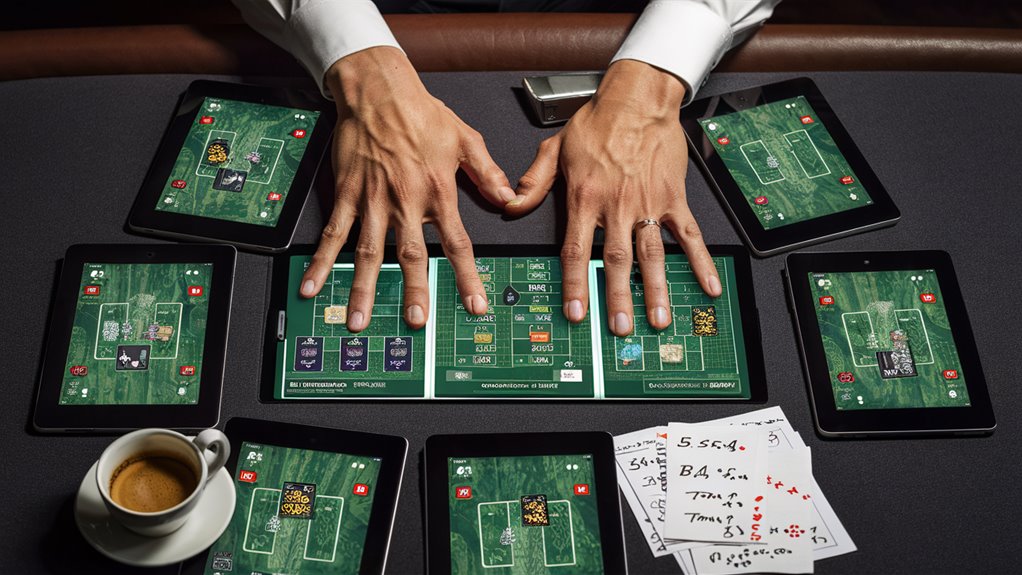
Dovetail Surge Poker: Fitting Tiny Tells Into Powerful Pot Assemblies
Mastering Micro – Tells in Multi – Table Poker Strategy
Advanced Scanning Methods of the Table
The basic timing patterns of multi-table poker analysis, the 3-2-1 method, should be implemented across tables to build consistent telling opportunities against players. This systematic approach allows for precise tell detection even as every table remains well watched.
Physical Tell Identification
During the key moments of play, pay attention to these physical indicators:
- Asymmetrical arrangements of the mouth
- Nasal flares
- Bet timing variations made by players
- Where players place their hands
Strategy Implementation in Timing
To obscure your own patterns while gathering information on opponents, keep a steady 2-3 second offer timing. Insert timing tells into position, busy signal monitoring, and stack depth analysis to form extremely complex betting lines.
Framework for Analyzing Sessions
Track and identify trends within a single session, allowing for behavioral evolution over multiple sessions. Break this down systematically into:
- Correlation between the size of bets and timing
- Occasional timing tolling variations
- Clusters of bodily responses
- After making adjustments based on position
Creating Powerful Pot Assemblages
Combine micro-tell detection with strategic Seafoam Shimmer Bets pot assembly by being aware of:
- Stack-to-pot ratio thresholds
- Advantaging oneself (positionally)
- Timing tells’ amalgamation
- How frequently and when to adjust
Signal Integration System
By linking together:
- Table dynamics
- The personal profiles and individual history of each player
- Pattern analysis of bets made
- Frequency, or more precisely base > ‘, adjustments in positioning
Micro Expressions in Surge Play
Mastering Micro-Expressions in Surge Poker
Vital Facial Areas For High-Speed Playing
Micro-Expressions analysis is essential when you have to make instant decisions like those in Speed Poker.
Three key parts of the face are critical to watch closely here for just those reasons when they occur:
- The corners of the mouth: Recognizing real smiles from false ones
- The ridge above the eyes: In cases of stress more intense than any such facial movement might indicate
- Throat area: As it’s traditional for players to swallow all sorts of underhanded poisons during a game of cards
Systematic Tell Monitoring
Facial signal identification should be carried out in rapid poker. Key signals include:
- The mouth continued to tighten after betting is finished. Right over the top
- Rates of blinking that go over 20 times a minute are, with few exceptions and often far fewer than 2, signs stress is reaching the surface quickly
- With betting sequences that are drawn out but not delayed as such and nostrils produce brief flares, it almost always means a good hand is coming up again.
Unique Dose Points in A Surge Format
Surge Poker’s sped-up nature gives rise to some unique behavior patterns:
- Double the number of self-soothing movements
- Increased temple tapping and throat scratching
- Spreading of the gospel of micro-expression behavior among crowd gathering poker equipment
- Size of bets closely correlates with specific physical postures
This comprehensive understanding of micro-expressions patterns can provide crucial advantages to a player in the fast decision-making environment of Surge Poker because of its ultra-short observation time influencing play outcomes greatly.
Speed Pattern Recognition Techniques
Professional Pattern Recognition on Poker
Core Concepts of Recognition
Pattern recognition fundamentally shifts information processing at the poker table.
The three elements that you must take into account when successful in tracking patterns:
- Bet structure
- Timing tells
- Positional-based decisions
Multi-Hand Tracking System
A systematic mental grid lets you track four opponents’ hands at a time.
Key study areas are:
- Recurrent standard bet size deviations
- Regular typical percentages
- Player-specific tendencies
Three-Two-One Scanning Method
Use proven 3-2-1 scanning techniques:
- Monitor three prepositional players.
- Notice two postpost players.
- Follow one door in positional change that begins to display a variety of behavior.
Advanced Analysis Patterns
Pattern Recognition Based on Timing
In 15 second increments follow bet timing. Record any disturbances of rhythm.
Recognition Predictive Indicators
Pattern Integration With Positional Algebra
After making range adjustments, monitor sequences of behavior. Map for strategic trends.
By combining timing patterns and position-based tendencies, you can:
- Foresee enemy decisions
- Recognize orderly sequences
- Make use of behavioral patterns
- Get the drop on tactics in fast formats
With properly implemented, these unified pattern recognition techniques provide a person with an upper hand in high-stakes competition.

Playing Poker by Ear Controlled Betting Tempos in Poker
Playing Poker by the Beat
Betting tempos generate carveable exploits for players who take advantage of them with proper timing.
TableSide There, which Emph Minute?
Betting cadences provide vital tells on timing Shadowglow Casino during a hand, particularly the interval between decision points and player response.
Key Timing Indicators
- Snap-Bet Patterns: Traditionally, at a rapid pace (under 1.5 seconds) the shortened decisions tell us that the player either holds formidable cards or has prepared strategies. This quick member then sets patterns for experienced rivals to study and exploit with ease.
- Are quick 3-second decisions bad company? This time band of 2 to 4 seconds presents well-considered moves or else takes a path toward the middle-strength hand. It is a manifestation of opponent tendencies.
- The Butterfield Pause: A decision period that stretches on for 5 seconds or longer in most cases suggests complex hands and/or ideas. It is only during games at high stakes like this that these prolonged pauses prove especially revealing.
Advanced Temporal Control
Keeping a consistent betting rhythm, say every 2 to 3 seconds, hides your hand’s strength and helps avoid timing tells. This standardized approach allows for the collection of continuous data while keeping your opponents from getting any actionable timing information at all.
Tight Situations
Cut Cards and Painstaking Decision Making
The Last Four Outs Make or Break a Situation. Timing tells “blow up” on tense decision-making points and large pot decisions spread doubt. In this way, we can say that these moments are the times when timing tells give most benefit to strategic recognition. Whether the opponent is blushing when making a decision or holding a good hand, tracking betting rhythms at these times usually offers crystal-clear readings. Then one can tell what his tendencies are from those stances.
Pressing Time and Position
Position Position Position Poker Pleh: Tells Poker Master Class
Position-based strategy coordinates unusually well with tells on timing to form a splendid city of poker decision-making excellence. Fusing physical characteristics with the dynamics of position requires systematic observation and analysis.
Many poker websites will teach you to read timing tells, but they only mention the generic ones.
Betting times from late position are particularly important signals of hand strength. A quick bet is often taken to show that the player believes in his hand’s strength; conversely, a hesitant one indicates uncertainty and probably weaker cards.
Deciphering The Timing Of Tells
Timing tells are a strong indicator of the comfort level 토토커뮤니티 your opponent is experiencing and the strength of their hand. The key indicators of timing are:
- Baseline Decision Time.
- A departure from your usual patterns.
- The Strength Of A Tank (see Glossary) relative to the hand that is being played.
- The time you take to act.
Strategy Making In Advance
In order to be successful, you need constant reassessment of several factors. Compile a comprehensive dossier on your opponents by:
- Observing evolution patterns.
- Knowing what different kinds of responses can be expected.
- Taking advantage of imbalance between what an opponent’s tactics and their strategy.
- Constantly adjusting anti-tactics.
Stack Size Impact Resources
Stack Depths and Surge Poker Analysis
Stacks, Guns, and Life Lines
The way an opponent’s stack impacts the strategic setting in Surge Poker is a question of key importance.
Deep stacks (100BB+) enable sophisticated post-flop play and multi-street strategies. Shallow stacks make all-in decisions, and take off any marginal choices from pre-flop play down to simple shoves or calls of those bets which must be called because they’re often come.
Strategic Adaptations for Different Depths
Facing a large stack demands opening ranges that are tighter due to wider hand ranges among your opponents. Commitment typically extends his stack. The precise pot odds calculations that this requires and getting prepared to face a lot of all-ins.
Playing with a big stack opens up countless opportunities for tricks with minimal risk; every street can be used to exploit implied odds.
Placement-Based Stacking Strategy
The sophistication of your stacked position makes a big difference to your judgment. Strategies based on late position with deep stacks should call for increasingly frequent 3-betting to give post-flop maneuverability at its maximum.
In putting the short-stack case, the “all in” attribute carries far more weight in terms of which hands will be useful to us later.
So the whole endeavor depends on a fluid calculation depending on the stack-to-pot ratio (SPR) about every action one takes throughout each hand. Certain key considerations about stack size include:
- Big Stack Benefits: More strategic flexibility after the flop, complex betting lines.
- Small Stack Strategies: Look for situations in the pre-flop stage, simplicity of all-in confrontation.
- Position Influence: How you might change your 3-bet call-off ranges and which hands you select directionally in accordance with stacks.
- SPR Weight: Means of guiding strategy options and betting lines.
Multi-Table Tell Management
Managing Tells Across Multiple Tables
Body and Timing Tells
Mastering unconscious behaviors requires great awareness and careful choreography to be successful across multiple poker tables.
By making decisions within the same two to three second pattern, it can effectively hide far too many possible tells of position irrespective of hand situation – even strength of hands.
The resulting consistency means that opponents can never gain any meaningful insight into your activities.
Main Elements to Tell Management
Mouse Movement Betting Controls
For both closer objects (such as mouselands) and bribe buttons, mice act through frequency of movement. Basic information on these two physical clues is essential to determining betting intentions from your opponent.
To be successful and save time, use pre-designed patterns of raising and betting. This method removes betting patterns from across the sites that could give away whether you have a good hand or not in a multi-table situation at once – stretching so far as to include sizes.
Physical Casino Betting Behavior
Tell Management and Life Position
Proper placement of the seat is essential to manage tells.
Continued adherence to specific chair heights and screen heights removes a natural signal for good holdings, that of leaning forwards towards your table. Controlled placement allows a uniform presence which covers all the active multi-tables in this way.
Performance Evaluation and Improvement
Repeated Watching of Session Recordings Features Unveil Unconscious Tells in Action
Weekly analysis of key hand sequences identifies exploitable patterns. This systematic review process leads to continued improvement in multi-table poker tell concealment.

